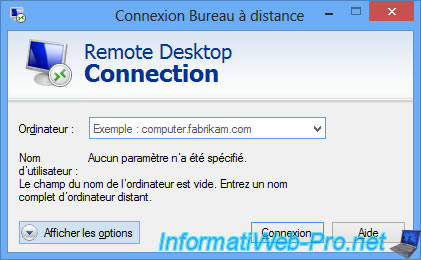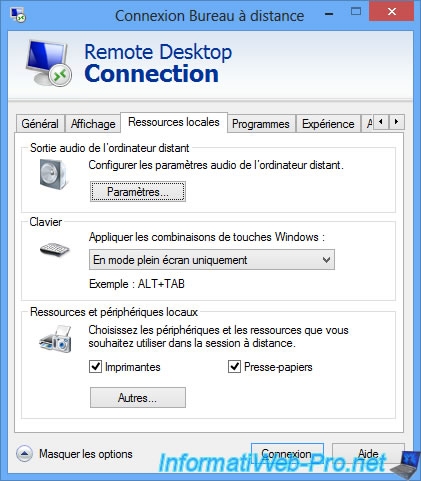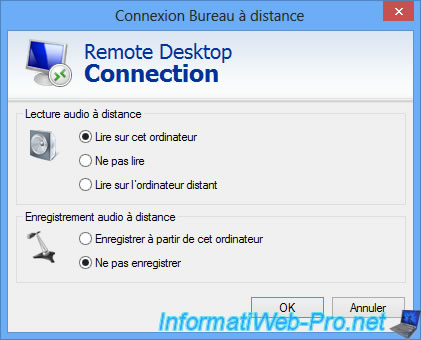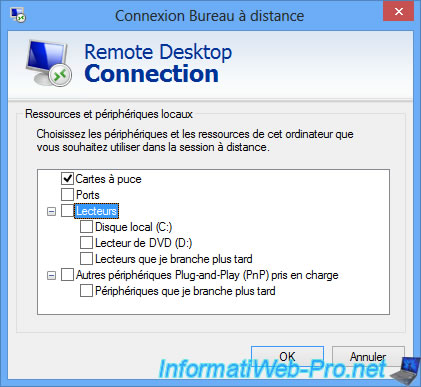Manage resource and printer redirection to speed up access to your RDS infrastructure on Windows Server 2012 / 2012 R2 / 2016
- Windows Server
- 22 June 2019 at 11:44 UTC
-

- 2/2
4. Manage resource and printer redirections through the RDP client options
The last possibility, which is the only one your users can also use (except if a group policy prevents it) is to use the Windows RDP client options.
Indeed, if you click on "Show Options", you will be able to manage the resource redirection of your client PC.

For example, in the "Local Resources" tab, you will be able to :
- manage audio redirection (playback and/or recording)
- enable or disable the redirection of your printers
- enable or disable the clipboard redirection

For the redirection of audio output, you will be able to manage the redirection of audio playback as well as audio recording.

For the "Local devices and resources" section, if you click the "More" button, you will be able to choose which local resources and devices you want to redirect :
- smart cards
- ports
- drives (with the list of your partitions)
- supported Plug and Play (PnP) devices : such as USB keys

To improve the connection time and the bandwidth usage, don't hesitate to go through the "Experience" tab.

5. Information about printer redirection
5.1. Easy Print
As you may have seen in the group policies mentioned earlier, there is a policy named "Use Remote Desktop Easy Print printer driver first".
When you enable this policy, your server will use the Microsoft Easy Print driver for client printers instead of the official driver for each printer.
Note that this feature is not new and is available from Windows Server 2008.

By enabling this policy and applying it to your session hosts, printers redirected from the client computers to your server will be recognized by your server as printers.
For example, on our client PC, we have local access to our printer "HP DeskJet 3630" which is recognized correctly by Windows as it tells us :
- manufacturer : HP
- model : HP DeskJet 3630

If we redirect this printer on our server (via Remote Desktop Connection / RDP), our server should install the driver for this printer so that we can print to our local printer from the server.
However, for this, it would be necessary that this printer is compatible with our server (which is not necessarily the case, especially if it's a printer for individuals and not professionals).
In addition, the administrator should install the driver on each session host server where we are likely to connect.

In short, we enable the policy mentioned above (about Easy Print), then we force the update of the policy on our session hosts.

Now, we can access our desktop via the web access of our RDS platform and we go in the control panel -> Hardware and Sound : View devices and printers.
If you select your printer, you will see that it's a redirect and the printer model is not "HP DeskJet 3630", but : Remote Desktop Easy Print.

In addition, if you open the properties of this printer, Windows will tell you that it recognizes it as a simple Remote Desktop Easy Print printer.

In the device manager, you will also see the real name, but the driver will be from Microsoft and not from the original printer manufacturer.

5.2. Limit the number of printers to redirect on server
To limit the number of printers to redirect on the server and thus improve connection time, bandwidth usage, and so on, you can choose to redirect only the client's default printer to its RDS session.
For example, you can use the "Redirect only the default client printer" policy.

Enable this policy.

On the remote session, you will only see the printer defined by default on your client PC.

This will also limit the number of devices that your server will need to manage.

Share this tutorial
To see also
-

Windows Server 6/7/2019
WS 2012 / 2012 R2 - RDS - Set up HA on your RDS infrastructure
-

Windows Server 3/8/2019
WS 2012 / 2012 R2 / 2016 - RDS - Access RemoteApp via a modern application
-

Windows Server 4/28/2019
WS 2012 / 2012 R2 / 2016 - RDS - Attempt to unblock the session as a user
-

Windows Server 3/16/2019
WS 2012 / 2012 R2 / 2016 - RDS - Change the properties of RemoteApps

No comment